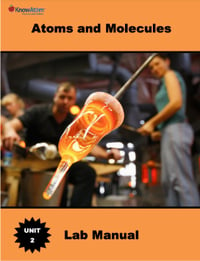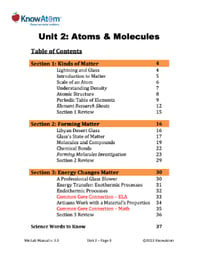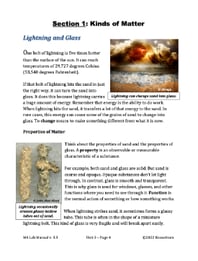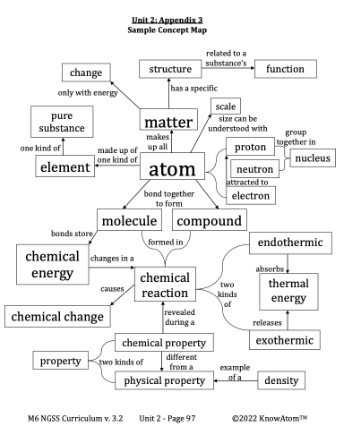Once students understand the basic structure of atoms, they then focus on how atoms are like children’s building blocks, forming molecules and compounds by combining with other atoms to create all of the matter in the universe.
In this unit, students explore the science phenomena of interactions between energy and matter, analyzing how matter can only change when enough energy is present. In this lesson, they investigate the structure of molecules, relating this structure to the matter’s properties. This page is a high-level extract of this lesson.
Science background provides teachers with more in-depth information on the phenomena students explore in this unit. Below is an excerpt from this section on molecules.
The atoms in a liquid are less tightly packed than in a solid. They are in constant contact with one another, but they have enough energy to slide past one another. Therefore, matter in a liquid state takes the shape of its container because it has no shape of its own.
When thermal energy is removed from a liquid, the kinetic energy of the atoms and molecules decreases, causing them to slow down. When enough thermal energy is removed, the liquid will turn into a solid. This is called its freezing point. For example, water freezes when the temperature reaches 0 degrees Celsius (32 degrees Fahrenheit). The freezing point of a liquid is generally the same as the melting point of a solid.
Glass is so unusual because it is formed when liquid sand cools so rapidly that there isn’t time for the lattice-like structure of the solid sand to re-form. Because glass has cooled, however, its atoms and molecules are held rigidly in place so they cannot flow. This is why glass is sometimes called a rigid liquid.
Glassblowers use this scientific knowledge about the molecular structure of glass to produce many different kinds of products. For example, there are many different kinds of glass made today, with unique chemical and physical properties.
When enough thermal energy is added to a liquid, the atoms or molecules will move so quickly that the liquid will expand, becoming a gas. This is called a substance’s boiling point. The molecules in a gas have so much energy that they move far apart and bounce around randomly. As a result, matter in a gas state has no shape and spreads out into space. If a certain amount of gas is taken out of one container and placed into a container that is twice as large, the gas will expand to fill the larger container.
Atoms are like Lego pieces. They can fit together with other atoms to form a bigger piece of matter. Atoms combine by forming bonds with other atoms. Whenever two or more atoms bond, they form a molecule. To bond means to join together. A compound is a combination of two or more different kinds of atoms bonded together. For example, oxygen (O2) is a molecule but not a compound because it is made up of two oxygen atoms bonded together.
In contrast, water (H2O) is both a molecule and a compound because it is made up of two hydrogen atoms and one oxygen atom. Water is also an example of a pure substance because it is made up entirely of one kind of atom or molecule that has distinct properties that do not vary from sample to sample.
Sand is primarily made up of the compound silicon dioxide (SiO2). Silicon dioxide is also called silica. Each molecule of silica contains one atom of silicon and two atoms of oxygen bonded together. One of the reasons that Libyan Desert glass is so unusual is that it is the purest natural silica glass ever found on Earth. Most sand contains a mixture of different molecules in addition to silica.
Molecules and compounds hold a form of potential energy stored in their bonds. This potential energy is called chemical energy. This chemical energy is what allows new molecules and compounds to form.
Molecules and compounds bond because of the attraction between protons and electrons. When two atoms approach one another, the electrons of each are attracted to the protons of the other. Remember that atoms have electron shells, and that each shell can only hold a certain number of electrons. Atoms bond together because they seek full atomic shells. Some atoms have just a few electrons in their outer shell. These atoms are likely to transfer those extra electrons to atoms with nearly complete outer shells.
Sometimes two atoms do not transfer electrons between them, but end up sharing the electrons. Water (H2O) is an example of a compound created by shared electrons. The oxygen atom needs two more electrons to have a complete outer shell, and the hydrogen atoms each need one electron. When the hydrogen and oxygen atoms come together, the oxygen atom shares one electron with each of the hydrogen atoms, and the hydrogen atoms each share one electron with the oxygen atom.
The water molecule is joined by a double bond. A double bond is formed when two or more atoms share four electrons. Some molecules are joined by a single bond, when two electrons are shared. And other molecules are joined by a triple bond, which is formed when two or more atoms share six electrons.
Once students understand the basic structure of atoms, they then focus on how atoms are like children’s building blocks, forming molecules and compounds by combining with other atoms to create all of the matter in the universe.

Prepared hands-on materials, full year grade-specific curriculum, and personalized live professional development designed to support mastery of current state science standards.
Chemical Change : a change that rearranges the chemical structure of substances through a chemical reaction
Chemical Energy : a form of potential energy held in the bonds of atoms and molecules
Chemical Reaction : a change that rearranges the atoms of the original substances into a new substance that has different properties from the original substances
Compound : a combination of two or more different kinds of atoms bonded together
Molecule : a combination of two or more atoms bonded together
Thermal Energy : the motion of atoms and molecules in a substance or object as its temperature increases

Libyan Desert Glass
In 1996, an Italian scientist noticed an unusual gem in one of Tutankhamen’s necklaces. Tutankhamen was an Egyptian pharaoh who ruled between 1331-1323 BC. He is sometimes called King Tut. The Italian scientist was interested in a yellow- green gem that he saw in King Tut’s necklace. When the gem was tested, it was found to be glass. However, it was older than the oldest Egyptian civilization.
What Formed the Glass?
How this glass was made is a question that scientists are still trying to answer. It came from a stretch of desert in Africa called the Libyan Desert. More than one thousand tons of this kind of glass have been found there. Scientists have dated this glass to be more than 26 million years old. It is generally yellow, and it can be translucent or almost opaque. Translucent substances can partly be seen through. Opaque substances block all light.
Scientists believe that this Libyan Desert glass may have formed when a meteorite hit Earth or when a comet from space exploded in Earth’s atmosphere. Both of these events would have provided the extreme temperatures necessary to change the desert sand into glass.


Glass’s State of Matter
Glass is unlike any material on Earth. Scientists sometimes refer to glass as a rigid liquid because it isn’t quite a solid, and it’s not exactly a liquid. This is because of the extreme temperatures that form glass.
Whether a substance is a solid, liquid, or gas depends on the amount of thermal energy present. All matter has thermal energy, which is the motion of atoms and molecules in a substance or object as its temperature increases. Temperature is a measure of heat. Heat is energy transferred when two objects or systems are at different temperatures. It always transfers from hotter substances to cooler substances. The faster that atoms and molecules move, the more thermal energy they have and the warmer they become.
Sand is a solid at room temperature. The atoms in a solid are closely packed together. They are always moving, but because of how close they are, they can only vibrate in place. They cannot move past one another. Because of this, solids keep their shape until something changes them.
When thermal energy is added to solids, the atoms or molecules begin to move more quickly. When enough energy is added, they will expand and become a liquid. The temperature at which a substance changes from a solid to a liquid is a property of matter called its melting point.
This is what happens when lightning or a meteor comes into contact with sand. When sand is heated to such a high temperature that it melts, it becomes a liquid. Its atoms and molecules are moving much faster, and can slide past one another. Different substances have different melting points depending on how much energy is needed to change them from a solid to a liquid. This in turn depends on the kind of atoms that make them up.
In this lesson, students explore the phenomena of molecular bonding by modeling the atomic composition of simple molecules with varying levels of complexity. Students use their model molecules to analyze how the properties of substances depend partly on the elements that make them up, but also on the ways in which the elements bond and the quantities of each element present.
KnowAtom incorporates formative and summative assessments designed to make students thinking visible for deeper student-centered learning.

Standards citation: NGSS Lead States. 2013. Next Generation Science Standards: For States, By States. Washington, DC: The National Academies Press. Neither WestEd nor the lead states and partners that developed the Next Generation Science Standards were involved in the production of this product, and do not endorse it.